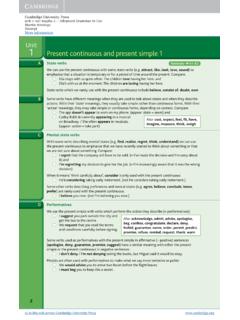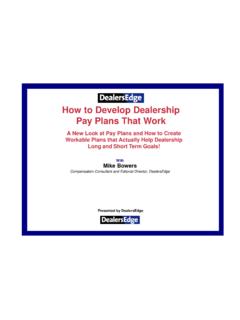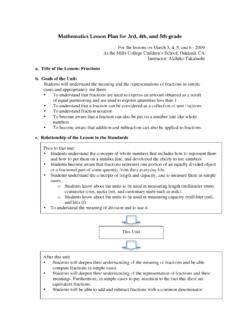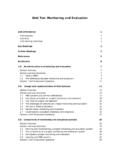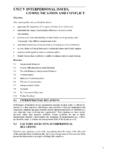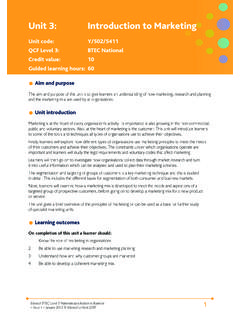Transcription of Unit 1. MARKETING MIX Contents : Meaning and …
1 1 unit 1. MARKETING MIX Contents : Meaning & Definitions, Four P s of MARKETING Mix : Product, Price, Promotion, Place, Product A) product- Meaning product quality, product design, product features, Difference between brand name and trade mark, after sales service, packaging- Role and functions of packaging Meaning and Definitions of MARKETING Mix While doing market planning, the MARKETING manager of a company obtains MARKETING information to assess the situation. He does the market segmentation on the basis of such information and sets the MARKETING objectives to be achieved through the satisfaction of needs and wants of the consumer population in these market segments.
2 For each segment of market, he formulates a MARKETING programme to cater the needs of consumers. A combination of MARKETING methods and activities, integrated into a MARKETING programme to achieve MARKETING goals through satisfaction of consumer needs in a market is called MARKETING mix. A MARKETING mix is made of four elements, namely (1) Decisions on product or services, (2) Decisions on price, (3) Decisions on promotion and (4) Decisions on distribution of goods and services to the place of consumer. The concept of MARKETING mix was evolved by Prof.
3 Of Harward Business School of America. In his words, MARKETING mix refers to two things. (a) a list of important elements or ingredients that make up the MARKETING programme and (b) the list of forces having bearing on MARKETING operations. According to Mr. Jerome McCarthy, MARKETING mix is a pack of four sets of variables, namely product variable, price variable, promotion variable, and place variable . In simple words MARKETING mix means a MARKETING programme that is offered by a firm to its target consumers to earn profits through satisfaction of their wants.
4 Such a MARKETING programme is a mixture of four ingredients, namely Product mix, Price mix, Place (Distribution) mix and Promotion mix. Product mix indicates the decisions of the firm regarding the product design, product range, product packing, product quality, product branding, product labeling and after sale service. 2 Price mix reflects the managerial decisions of the business pertaining to pricing policies and strategies, terms of credit, terms of delivery, margin of profit, discount and allowances. Place (Distribution) mix is made up of managerial decisions about the channels of distribution, transportation, warehousing and inventory control.
5 Promotion mix covers variables such as personal selling, advertising, publicity, sales promotion, public relations, trade fairs and exhibitions used in promotion of sales. Four P s of MARKETING The term MARKETING Mix, popularly known as 4P s, was given by Jerome McCarthy. He classified the MARKETING mix into four heads beginning with the alphabet P , namely (1) Product, (2) Price, (3) Promotion, (4) Place (Physical Distribution) as shown in the following figure. Let us discuss these 4 elements of MARKETING mix in detail.
6 (1) Product Product is the main element of MARKETING . Without a product, there can be no MARKETING . A product is anything that can be offered to a market for attention, acquisition, use or consumption that might satisfy a want or a need , says Philip Kotler. According to Alderson, Product is a bindle of utilities, consisting of various product features and accompanying services . A product stands for the organization s offer to the market place. It provides physical comfort and psychological satisfaction to the buyers.
7 It may be both tangible or intangible. Tangible product 3 is one that can be seen and touched in its physical presence. The examples are - garments, shoes, mobiles, vehicles, soaps, vegetables, etc. Intangible product is one that cannot be seen and touched, but can be felt. It is in the form of services. The examples of intangible products are - education, medical care, insurance, banking, travel and transport, holiday resorts, etc. Product is the most important element of MARKETING mix. Hence, the MARKETING manager has to put all his efforts in framing MARKETING strategies of its product offered to the market.
8 In doing so, all the sub-elements of product are to be considered. The sub-elements (or variables) of product are - product design, product range, product line, product package, product features, product quality, product branding, trade mark, labeling, after sale services and guarantees, etc. A proper combination of these sub-elements gives a product its ability to succeed in market. Product strategy also covers the MARKETING decisions about product modification, product simplification, removal of non-profitable products, etc.
9 (2) Price Price is the value of a product expressed in monetary terms. It is the amount charged for the product. According to Philip Kotler, Price is the amount of money charged for a product or service, or the sum of the values that consumers exchange for the benefits of having or using the product or service. Price is the second element of MARKETING mix. The product has to be adequately priced. Price is the only element that brings revenue to the business. The other elements of MARKETING mix, such as product, promotion and physical distribution involve expenditure.
10 Hence, pricing should be done with utmost care .The factors considered while determining the prices are target customers, price elasticity of demand, cost of production, level of competition, government restrictions on price, if any, and social responsibility of business. A proper pricing policy in different market conditions determines the acceptance of the product by the customer. The sub-elements of price are - price level, pricing policies, margin of profit, terms of credit, terms of delivery, rebates and discounts, resale price, maintenance, etc.
